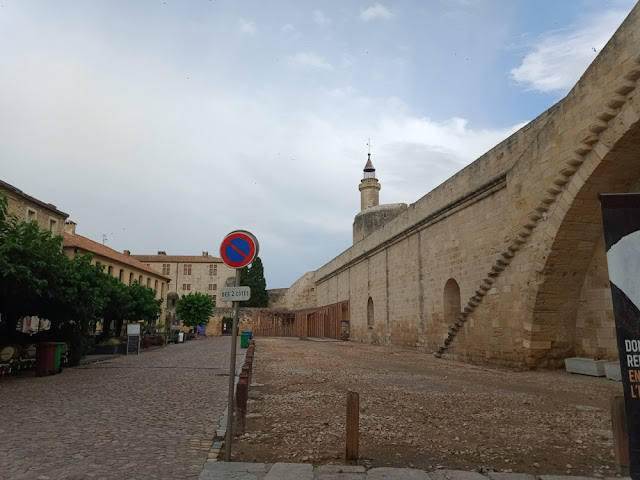Aigues-Mortes, or in Occitan, Aigas Mòrtas, is a small town in the Petite Camargue, in the southernmost part of Gard, in the region of Occitanie, on the Mediterranean coast, about 30 kilometres from Nimes and Montpellier. The climate is hot-summer Mediterranean and the town sits in the delta of the Rhone, with the river Vidourle flowing through it, as well as several canals and other water courses. As a result it is somewhere you will see a variety of canal boats and barges. It is surrounded by nature reserves, sites of special scientific interest, shallow man made lakes known as étangs, and coastal saltmarsh. The birdlife in the area is considered particularly important, with 240 species having been recorded, 50 of which use the surrounding habitat to breed.
The town is famous for its ramparts and arenas where traditional Camarguaise bull fights are held. It is also a significant producer of salt in traditional salt pans. Salt has been produced here since Neolithic times, and the inhabitants were exempt from the the hated salt tax that was introduced in the Middle Ages. Winters are mild and summers hot, with lots of sun and frequent gusty strong winds. Climate change seems set to make the area hotter and drier, and the community is hit by severe flooding and storms at least once a decade.
Aigues-Mortes was where Louis IX (Saint Louis) embarked in 1248 on his first Crusade (the Seventh) and in 1270 on his second (the Eighth) and last. The name Aigues-Mortes means 'stagnant' or 'dead water', and the town is surrounded by water nobody can drink. Louis IX had the port and ramparts constructed so he had a strategic Mediterranean base, and was no longer dependent on the Italian maritime republics for transport to the Crusades. At the time there was already an 8th century tower there which Charlemagne had built as a watchtower to protect fishermen and salt pan workers. In Charlemagne's time though the inhabitants lived in huts hidden amongst the reeds.
From the 15th century Aigues-Mortes began to silt up and lose access to the sea. It was losing strategic value, and only the importance of the salt industry caused the authorities to work on solutions. Nothing was very successful until in the 19th century the river port was connected to the Rhone - Sete canal, and excessive clearing of the surrounding land, which had been causing erosion and alluvial deposits, was discouraged.
In the 16th century, during the Wars of Religion, Aigues-Mortes was one of the eight official safe havens for Calvinists. Early in the 17th century Jean d'Harambure, one of Henri IV's closest Protestant companions, who was also given lands in and around Preuilly, was the governor. Once the Edict of Nantes was revoked by Louis XIV in 1685 the most of the inhabitants of Aigues-Mortes either converted to Catholicism or went into exile. But 15 year old Marie Durand was imprisoned in one of the towers and held for 38 years, during which time she carved the word 'résister', still visible on the edge of a well.
In 1893 Aigues-Mortes was the site of the worst pogrom in French history. The targets were Italian immigrant salt industry workers. No one was ever charged or convicted with any crime associated with the event and it caused a diplomatic incident.
The black bulls and white horses of the Camargue are raised in the marshes surrounding the town so they are practically wild. The Camargue bull is the smallest of the Spanish fighting breeds. It is mainly used for bull running and fighting events. The Camargue horse is an indispensible companion to the Gardians, as the herders are known. It seems that the prehistoric Solutré horse which lived in the Rhone valley 10 000 years ago is the breed's ancestor. They are not very big, and are enormously resilient and adapted to their environment. They are born dark brown, and go progressively whiter after a few years.
The medieval old centre of Aigues-Mortes is well preserved and attracts thousands of tourists (like us -- we had breakfast there one day). The ramparts are in a remarkable state of preservation, despite not having undergone the same level of restoration as Carcassone in the 19th century, for example.



1 comment:
I remember going up on top of the ramparts and turning all around the village. That was in 1954 before going to Carcassonne.
Post a Comment